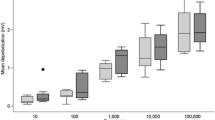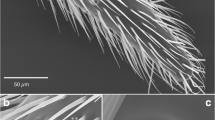Abstract
Electroantennograms were recorded fromScolytus multistriatus in response to 4-methyl-3-heptanol, the four geometric isomers of multistriatin, and cubeb oil. Charateristic dose-response curves for response amplitude and the time required for the voltage trace to return to 1/2 baseline (recovery rate) were established. Recovery rates were significantly more rapid following stimulation with 4-methyl-3-heptanol or cubeb oil than with the multistriatin isomers. At most intensities, α-multistriatin, the isomer that evokes behavioral response, gave significantly larger EAGs with significantly longer recovery rates than the other isomers. Results of differential adaptation experiments suggested that 4-methyl-3-heptanol interacted with the processes involving multistriatin and cubeb oil activity. However, cross-activity of acceptors for these compounds seems unlikely; single sensillum recordings are needed to ascertain the response spectra for individual receptor neurons.
Similar content being viewed by others
References
Angst, M.E., andLanier, G.N. 1979. Electroantennogram responses of two populations ofIps pini (Coleoptera: Scolytidae) to insect-produced and host tree compounds.J. Chem. Ecol. 5:131–140.
Angst, M.E., Lanier, G.N., Mueller, C.A., Jans, P.A., andBenz, G. 1982. Response ofScolytus multistriatus (Coleoptera: Scolytidae) to α- and δ-multistriatin in Switzerland.J. Chem. Ecol. 8:1345–1352.
Chapman, J.W. 1910. The introduction of a European scolytid (the smaller elm bark beetle,Scolytus multistriatus Marsh) into Massachusetts.Psyche, 17:63–68.
Cuthbert, R.A., andPeacock, J.W. 1978. Response of the elm bark beetleScolytus multistriatus (Coleoptera: Scolytidae), to component mixtures and doses of the pheromone multilure.J. Chem. Ecol 4:363–373.
Elliott, W.J., Hromnak, G., Fried, J., andLanier, G.N. 1979. Synthesis of multistriatin enantiomers and their action onScolytus multistriatus (Coleoptera: Scolytidae).J. Chem. Ecol. 5:279–287.
Felt, E.P. 1935. Bark Beetles and the Dutch elm disease.J. Econ. Entomol. 28:231–236.
Gerken, B., Grüne, S., andVité, J.P. 1978. Responses of European populations ofScolytus multistriatus to isomers of multistriatin.Naturwissenschaften 65:110–111.
Gore, W.E., Pearce, G.T., andSilverstein, R.M. 1975. Relative Stereochemistry of multistriatin (2,4-dimethyl-5-ethyl-6,8-dioxabicyclo[3.2.1]octane).J. Org. Chem. 40:1705–1708.
Kaissling, K.E. 1971. Insect Olfaction,in L. Beidler (ed). Handbook of Sensory Physiology, Vol. IV, Chemical Senses, 1. olfaction. Springer-Verlag, New York.
Kaissling, K.E. 1974. Sensory transduction in insect olfactory receptors, pp. 243–273, L. Jaenicke (ed.).Biochemistry of Sensory Functions, Springer, Berlin.
Klimetzek, D., Baader, E.J., andHelbig, W. 1981. Die Eignung von Lockstoff-Fallen zur Üeberwachung der Ulmensplintkäfer.Allg. Forst. Jagdztg. 152:113–119.
Lanier, G.N., Gore, W.E., Pearce, G.T., Peacock, J.W., andSilverstein, R.M. 1977. Response of the European elm bark beetleScolytus multistriatus (Coleoptera: Scolytidae) to isomers and components of its pheromone.J. Chem. Ecol. 3:1–8.
Martin, C.H. 1936. Preliminary report of trap-log studies on elm bark beetles.J. Econ. Entomol. 29:297–306.
Meyer, H.J., andNorris, D.M. 1967. Behavioral responses ofScolytus multistriatus (Coleoptera: Scolytidae) to host-(Ulmus) and beetle-associated chemotactic stimuli.Ann. Entomol. Soc. Am. 60:642–647.
Payne, T.L. 1970. Electrophysiological investigations on response to pheromones in bark beetles.Contrib. Boyce Thompson Inst. 24:275–282.
Payne, T.L. 1975. Bark Beetle Olfaction. III. Antennal olfactory responsiveness ofDendroctonus frontalis ZimmermanD. brevicomis Le Conte (Coleoptera: Scolytidae) to aggregation pheromones and host tree terpene hydrocarbons.J. Chem. Ecol. 1:233–242.
Payne, T.L., andDickens, J.C. 1976. Adaptation to determine receptor system specificity in insect olfactory communication.J. Insect Physiol. 22:1569–1572.
Peacock, J.W., Lincoln, A.C., Simeone, J.B., andSilverstein, R.M. 1971. Attraction ofScolytus multistriatus (Coleoptera: Scolytidae) to a virgin female-produced pheromone in the field.Ann. Entomol. Soc. Am. 64:1143–1149.
Pearce, G.T., Gore, W.E., Silverstein, R.M., Peacock, J.W., Cuthbert, R.A., Lanier, G.N., andSimeone, J.B. 1975. Chemical attractants for the smaller European elm bark beetleScolytus multistriatus (Coleoptera: Scolytidae).J. Chem. Ecol. 1:115–124.
Roelofs, W.L. 1976, The scope and limitation of the electroantennogram technique in identifying pheromone components, pp. 147–165,in N.R. McFarlane (ed.). The Evaluation of Biological Activities. Academic Press, New York.
Roelofs, W.L. 1978. Threshold hypotheses for pheromone perception.J. Chem. Ecol. 4:685–699.
Roelofs, W.L., andComeau, A. 1971. Sex pheromone perception: Electroantennogram responses of the red-banded leaf roller moth.J. Insect Physiol. 17:1969–1982.
Author information
Authors and Affiliations
Additional information
From a thesis submitted as partial fulfillment of the Masters of Science degree, Department of Environmental and Forest Biology, SUNY College of Environmental Science and Forestry, Syracuse, New York 13210.
Rights and permissions
About this article
Cite this article
Grant, A.J., Lanier, G.N. Electroantennogram responses ofScolytus multistriatus (Coleoptera: Scolytidae) to its pheromone components and to associated compounds. J Chem Ecol 8, 1333–1344 (1982). https://doi.org/10.1007/BF01403097
Received:
Revised:
Issue Date:
DOI: https://doi.org/10.1007/BF01403097




